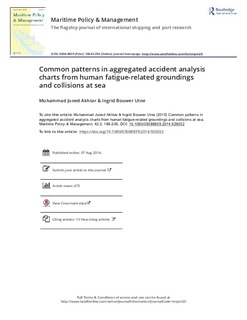| dc.contributor.author | Akhtar, Muhammad Juned | |
| dc.contributor.author | Utne, Ingrid Bouwer | |
| dc.coverage.spatial | Norway | nb_NO |
| dc.date.accessioned | 2019-12-17T11:13:28Z | |
| dc.date.available | 2019-12-17T11:13:28Z | |
| dc.date.created | 2014-10-14T15:37:00Z | |
| dc.date.issued | 2015-08-07 | |
| dc.identifier.citation | Maritime Policy & Management. 2015, 42 (2), 186-206. | nb_NO |
| dc.identifier.issn | 0308-8839 | |
| dc.identifier.uri | http://hdl.handle.net/11250/2633606 | |
| dc.description.abstract | Research has shown that there are potentially disastrous outcomes of human fatigue at sea. The conditions in which the seafarers have to operate are becoming more and more demanding. The study in this article attempts to aggregate accident charts derived from in-depth studies of human fatigue-related accidents to determine common patterns of interlinked fatigue factors. The accidents are analyzed by means of the Cognitive Reliability and Error Analysis Method (CREAM), which in the article has been modified for maritime accidents. The main fatigue factors identified are ‘shift work’, ‘irregular working hours’, ‘inadequate task allocation’, and ‘excessive demands’. The study reveals several differences between ship collision and grounding accidents and their corresponding fatigue factors. Human fatigue-related collision accidents are characterized by wrong/badly timed decisions, misconceptions, and poor communication between the vessels. Right before the collision the crew is often panicking and mistakes are easily made. In human fatigue-related groundings, the conditions are often monotonous and the navigating officer has either overlooked the upcoming seabed or simply fallen asleep. Safety climate issues are also identified as important contributors to human fatigue. | nb_NO |
| dc.language.iso | eng | nb_NO |
| dc.publisher | Taylor & Francis Group | nb_NO |
| dc.rights | Attribution-NonCommercial-NoDerivatives 4.0 Internasjonal | * |
| dc.rights.uri | http://creativecommons.org/licenses/by-nc-nd/4.0/deed.no | * |
| dc.title | Common patterns in aggregated accident analysis charts from human fatigue-related groundings and collisions at sea | nb_NO |
| dc.type | Journal article | nb_NO |
| dc.type | Peer reviewed | nb_NO |
| dc.rights.holder | © 2014 Taylor & Francis | nb_NO |
| dc.description.version | publishedVersion | nb_NO |
| cristin.unitcode | 7482,0,0,0 | |
| cristin.unitname | Transportøkonomisk institutt | |
| cristin.ispublished | true | |
| cristin.fulltext | original | |
| cristin.qualitycode | 1 | |
| dc.identifier.doi | 10.1080/03088839.2014.926032 | |
| dc.identifier.cristin | 1163995 | |
| dc.source.journal | Maritime Policy & Management | nb_NO |
| dc.source.volume | 42 | nb_NO |
| dc.source.issue | 2 | nb_NO |
| dc.source.pagenumber | 186-206 | nb_NO |

